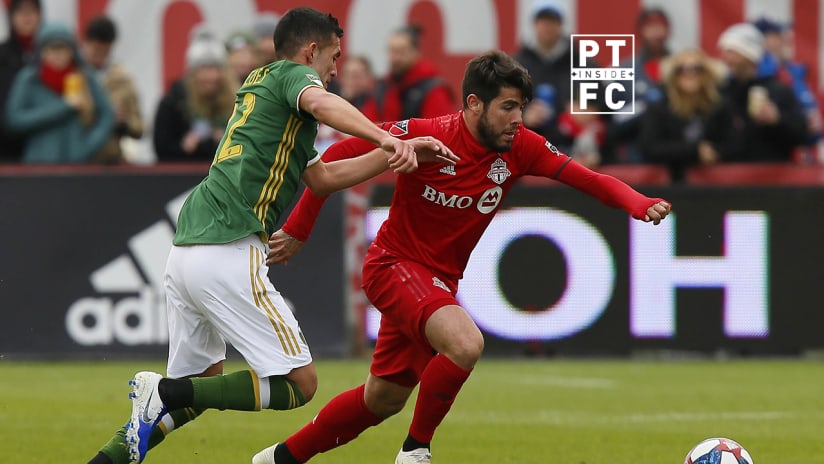There may be no greater compliment Timbers.com can give to an opposing player than devoting an entire post to him. Zlatan Ibrahimovic, Carlos Vela, Miguel Almiron and Sebastian Giovinco were all in the league last year, when this site’s editorial staff expanded, yet none of them have seen an entire piece dedicated to their threat. It’s just not something we’ve done.
That hints at the impact Toronto FC’s Alejandro Pozuelo, our sole focus today, has had over his first four Major League Soccer appearances. Arriving too late to begin the 2019 campaign with his next team, the 27-year-old debuted on March 29 with a two-goal, one-assist performance against New York City FC, leading the Reds to a 4-0, home result. In the three games that followed, the Real Betis product added two goals and four assists, leaving him with a gaudy if brief MLS resume: four games; four goals; five assists; steering Toronto to the best attacking rate in the league, prior to Saturday’s result.
Game |
Date |
Opponent |
Pozuelo |
Team |
|---|---|---|---|---|
1 |
3/29/2019 |
vs. NYCFC |
2g, 1a |
W 4-0 |
2 |
4/6/2019 |
vs. Chicago |
0g, 1a |
T 2-2 |
3 |
4/13/2019 |
at Seattle |
0g, 2a |
L 2-3 |
4 |
4/19/2019 |
vs. Minnesota |
2g, 1a |
W 4-3 |
5 |
4/27/2019 |
vs. Portland |
0g, 0a |
L 1-2 |
The Portland Timbers may have left BMO Field this weekend with a 2-1 result, but in isolated moments, they saw the Pozuelo who had bedeviled NYCFC, Seattle Sounders FC and Minnesota United FC. The touch he takes, below, to get move around Bill Tuiloma opponent is one example, …
… though this pass may be the more impactful. This is beautiful, line-breaking ball that draws a foul, setting up free kick which, after a parry from Timbers goalkeeper Steve Clark, gives Toronto their first-half, goal-scoring corner.
To Portland’s credit, these moments were scarce on Saturday. After claiming a place on the scoresheet in each of his first four MLS games, Pozuelo was held without assists or goals. Whatever the Spaniard was able to do so well before, the Timbers prevented on Saturday.
Or did they? It’s one thing to look at the scoresheet and pull out the banner, and say mission accomplished, and hope your delivery's confidence keeps the carrier afloat. It’s another for the underlying processes to be in line with those results. Particularly with striker Jozy Altidore missing for Toronto, Pozuelo’s absence from the scoresheet could reflect things that were beyond his control. Did Portland truly contain Pozuelo? Or was Pozuelo’s downturn caused by something else?
After the game, Timbers head coach Giovanni Savarese said, “Time and space, we had to take it away from him,” when asked how the team contained TFC’s focal point. Those are the usual areas of focus when developing a way to defend your opposition’s most creative players, but there’s a third, more improvisational element that matters, too: how your players react when the plan breaks down. Let’s take a look at all three of those areas to see how the Timbers were able to contain MLS’ newest star.
Space and spaces
There’s a literal interpretation of the word “space” that works, here. You want to deny a player room to execute. The first GIF, above, fits into that view, even if the outcome is not ideal. You don’t want to just give Pozuelo room to be Pozuelo.
There is another view of “space” that applies here, though, one that works more in terms of the areas you want to deny and the spaces you’re willing to give. For example, look at how the Timbers’ defense is set up, here, around a highlighted Pozuelo, who is looking to setup between Portland’s right-center back (Larrys Mabiala) and fullback (Jorge Moreira).
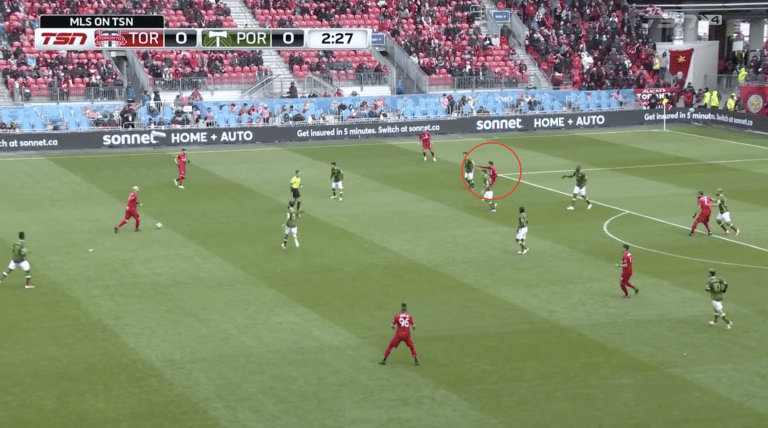
This is one of many areas Pozuelo frequented over his first four games of the season, often leaving him in a dangerous spot when defenders had to collapse on Altidore. With Altidore out, though, the focus on Pozuelo becomes more impactful. Even if Toronto is able to get Pozuelo the ball, there, Portland’s going to have multiple players there to deny him time and space, and their defensive shape, they’ve made it exceedingly unlikely Pozuelo is going to get the ball.
On the other side of the field, we see another example of that approach, if implemented slightly different. On their left flank, fullback Zarek Valentin was regularly coming up from his position early to mark Toronto's right midfielder, Nick DeLeon. Sebastián Blanco would take the player coming into the area, thus ensuring the two players most likely to feed Pozuelo were being cut off:

The last part of this approach comes down to Cristhian Paredes. His name's going to come up more, as we get into more highlights, below. But even in the match's early moments, it was clear that the Paraguayan would play a special part in shutting Pozuelo down.
Whether it be in the middle of the field ...
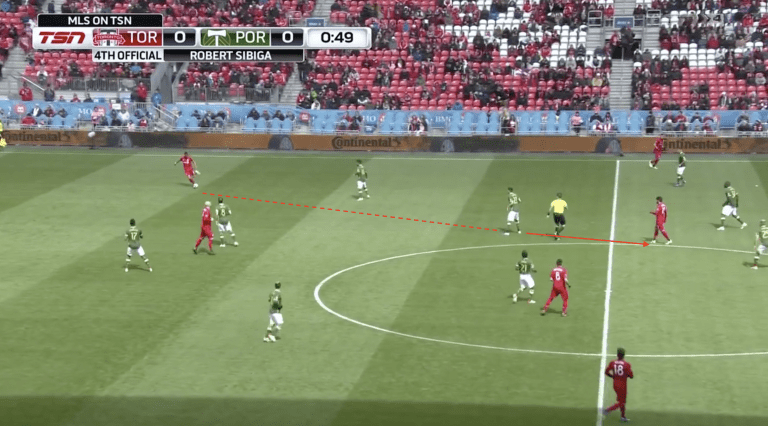
... on the Timbers' right ...

... the left ...

... or deep ...
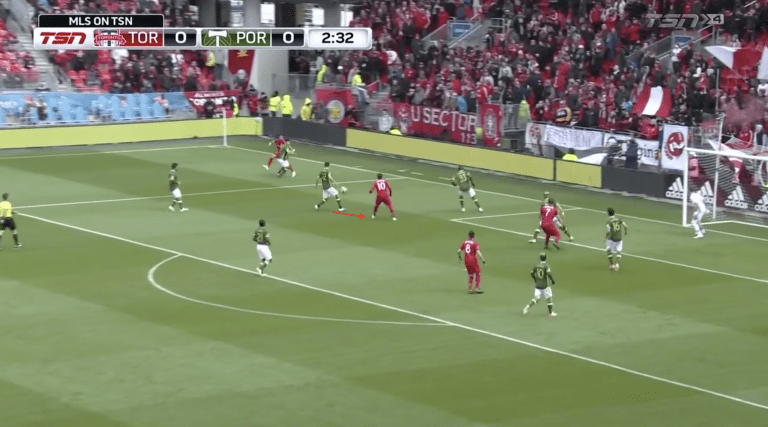
... Paredes always seemed near Pozuelo, and while he wasn't the only player who had to be cognizant of Toronto's threat, he was the one most often at the point of impact.
The end effect, here, is to give Toronto and Pozuelo a choice. Either he can stay between lines and hope his gravity creates space for others (and maybe, occasionally, touch the ball), or he can drop into deeper, less dangerous places to get the ball. That’s what happened, here …
… as well as here, an innocuous play except for Pozuelo’s reaction to the fourth official, afterward:
One of the keys to letting Pozuelo drift into those areas is marking sure that, what he looks back to the field, there’s nothing to exploit. If there’s room back toward the middle to find, say, a streaking Marky Delgado from midfield, or somebody like fullback Auro making an underlapping run, TFC’s best passer could still leverage his threat. Instead, as you can see above, Portland’s defense leaves few options.
That’s something that starts by being well organized higher up. Although there were moments when judicious pressing from forced turnovers in Toronto’s end, it was more common to see sequences like this one, where patience from Portland's forwards ensure that the team’s three lines of defense stayed connected:
That shot is also a place to see how Portland is defending on their left – Valentin coming up early; Blanco playing the opponent higher up.
I know, the forward play looks like nothing, but these are the little things that ensure each level of defense stays organized. Against a player like Pozuelo – somebody who can impact a game at all levels – that’s particularly important.
The urgency of time
The Timbers weren’t completely successful at denying Pozuelo the ball, and they were never going to be. The TFC star had 85 touches on Saturday, according to Opta. That’s his lowest total in MLS yet still illustrative of an obvious reality: You have to have a plan for when your target gets the ball.
Pushing him into less-dangerous spots is a start, but picking up from what we see in the first GIF, above, look at Paredes’ reaction, here, when Pozuelo is in possession.
Likewise, look at Paredes’ approach here – showing the urgency the team wanted when TFC’s most-dangerous player got the ball.
That response wasn’t always there, on Saturday. Here is a moment that turned into nothing, but when Pozuelo had time on the ball, below, he was able to play a nice ball wide, shifting the point of attack and putting Portland’s defense into motion. Moments after this, Pozuelo got the ball back and found Hamilton run's for that brilliant through ball, near the top.
Still, if those are the best examples you can come up with of somebody playing the ball, the defense has probably done a pretty good job. Come the end of the first half, most of Pozuelo's time in the middle of the field looked like this: standing; having passing angles to him cut off; dropped so deep that there's little incentive to get him the ball (he's next to Blanco):
This is how Savarese's two elements come together. You don’t give Pozuelo space. You force him into less-dangerous places. But when he does get on the ball, you don’t give him time. On rare occasions Saturday, TFC’s creator was able to digest the landscape and execute, but for the most part, players like Paredes treated him with the urgency he’s earned.
And when the plan doesn’t work
Even when the Timbers were attacking, they had to be mindful of Toronto’s star. Look at where the midfielders (Paredes and Diego Chara) are sitting, here, as they help maintain the team's balance …
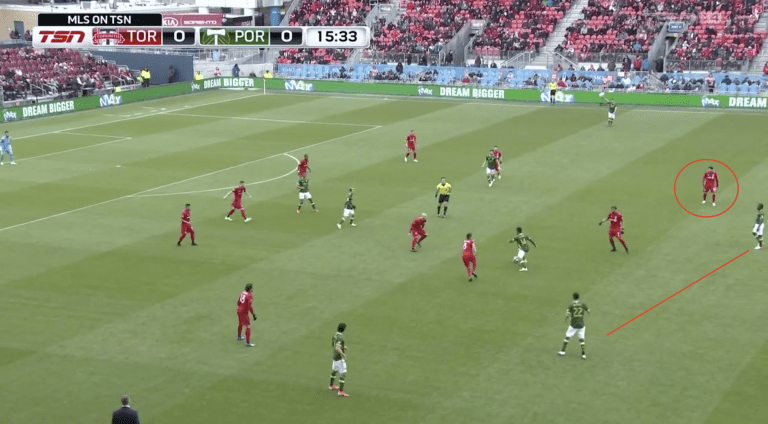
… and here, one of the many occasions when, acting like a typical two-man middle, one central midfielder adds a fifth player to the attack:
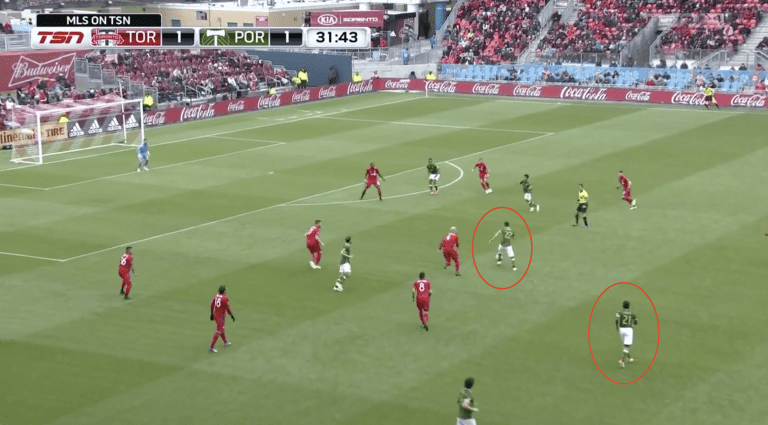
Maintaining balance is always valuable, but against a player like Pozuelo, it's necessary. All the talk, above, about time and space? Those are the two elements you have most in transition. With fewer attackers and defenders in the play, acres of field open up, and with defenders having to zone up, cover more space, the transition doesn't always afford extra players to drive opponents off the ball.
When those moments did arrive on Saturday, though, the Timbers players came up with solutions. For example, here, Tuiloma gives the ball away with a misdirected header. Moments later, he also makes up for his mistake with a good individual effort as Hamilton ran onto Pozuelo pass:
Or this moment, here, where Chara's deep positioning slows play enough for Paredes to fully end his progress.
Then there's this, when Pozuelo actually sees some daylight on the field. But there’s Chara, this time. And although he has to take a foul, Pozuelo's progress is stopped again.
Toronto FC coaches complained to the fourth official early about Paredes’ physicality, according to TSN’s broadcast. It’s something Pozuelo is bound to see more of, though, as this MLS season continues. Teams can scheme all they want and adjust their approaches, but at some point, even it’s rare, their approach is going to break down. When it does, strong execution and good decisions have to win out. Individual players have to step up.
The final results
Nothing the Timbers did, above, was particularly special. It didn’t even require them meaningfully changing their scheme. The results, however, were undeniable – and undeniable in a way that went beyond, “Well, actually, Altidore.” Across a number of different statistics, Portland held Pozuelo to season lows and below his MLS averages, and while, yes, that means we’re using a five-game sample as our point of reference, Portland has been MLS’ most successful team when it comes to limiting Pozuelo’s early returns.
Successful | Touches | Touches in | Chances Created | |
|---|---|---|---|---|
| Saturday | 51 | 85 | 0 | 3 |
| Average | 57.8 | 87.4 | 2.8 | 3.8 |
Passes into | Passing % | Shots | Shots in | |
|---|---|---|---|---|
| Saturday | 10 | 75 | 2 | 0 |
| Average | 17.8 | 79.39 | 2.4 | 1.2 |
As the season goes on, Pozuelo will undoubtedly come back to earth, and the hot start he’s enjoyed will feel more like a singular moment. He could prove the best player in the league, but he’s not going to be a 34-goal, 34-assist star. Still, Portland went into Saturday’s game knowing they had to address his threat, and by the numbers, they did so in a way that eluded Toronto’s previous opponents.
Deny time. Deny space. Step up when you can’t. It’s may not be complicated, but it was successful.

